Crazy Comparison!
Olympus E-M1 with 40-150 f/2.8 vs Sony A7s with 70-200 f/4
Many have asked for this as well as a Olympus/Sony/Fuji crazy comparison so I will start this one off with a Olympus vs Sony JUST FOR FUN Crazy Comparison! I will be using the E-M1 and the Sony A7s because the E-M1 is the flagship from Olympus and the Sony A7s is closest to the Megapixel count of the E-M1 as well as Sony’s “flagship” A7 series product. If I used the A7II it would have been an 8MP difference vs the 4 MP difference of the A7s and E-M1.
The two lenses used will be the Pro Olympus 40-150 f/2.8 which is a fantastic lens that gives an equivalent of 80-300mm with the light gathering of an f/2.8 lens. The Sony 70-200 f/4 has a constant f/4 aperture yet it is the larger lens with the Olympus being a bit smaller. They are the same price coming in at a cool $1500. The Olympus is weather sealed and has a great integrated slide out hood included.
Next week I will do another more involved comparison, probably my most extensive to date using the Fuji X-T1, Olympus E-M1 and Sony A7s or A7II.
For now, I will keep it simple with two shots. What i am looking for is sharpness, color performance, and overall pop of the shot. Just how much difference will there be using a flagship Micro 4/3 camera and lens vs a killer full frame A7s and premium telephoto?
1st up, a simple shot for detail and color and bokeh…
A simple tree shot to show detail, color and bokeh. 1st up, the Olympus shot. If you right-click and choose “open in new window” you will see the full size image where you can pixel peep to you hearts content. I love the color, sharpness and pop. The bokeh is quite nice as well. Used the 40-150 f/2.8 Zoom at 2.8. On my 27″ screen this image has some real POP and detail.
–
Same shot as above but resized with a full 100% crop embedded. To those who can’t see the full size shot for some reason, you can see the crop here.
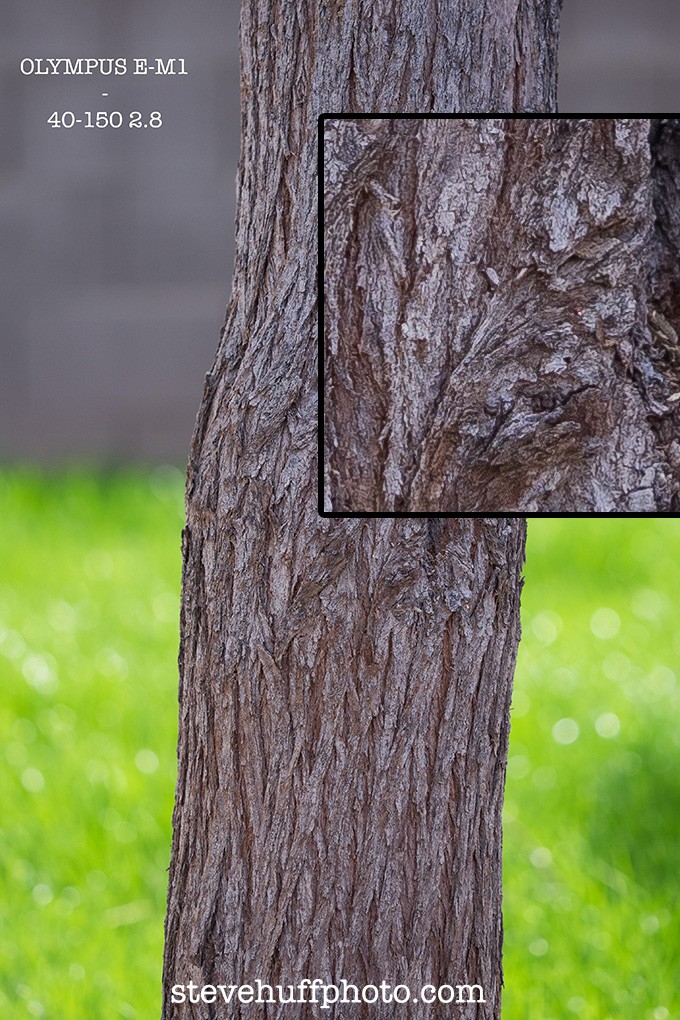
–
Now the Sony A7s, same shot. 70-200 Lens at f/4. The color is a bit dull in comparison to the Olympus as is the pop. Bokeh is a tad smoother though neither is bad. I love both in this regard. The Olympus is sharper and the edges are sharper as well with the E-M1 file. A tad more shallow DOF due to focal length differences. (True vs Equiv)
–
For those who can not see the full size shot above see the same image below resized with a full 100% crop embedded..
So from what I see here, the Olympus lens and E-M1 combo produce a more exciting image here. More pop, more detail and more OOMPH! You can see the color differences here easily. As for Bokeh/DOF, f/2.8 on the E-M1 is about the same as the f/4 – f/5.6 on the full frame Sony with a tad more blur going to the Sony (for DOF only). This is a true 40mm vs an 80mm here, so this is why. With the Olympus you are getting a TRUE 40mm f/2.8 and with the Sony a TRUE 80mm f/4. Longer focal length = less (more shallow) DOF. With the Olympus you are indeed getting TRUE f/2.8 light gathering and 40mm (not 80mm) f/2.8 DOF with an 80mm FIELD OF VIEW.
Let’s try one more image …here you can see the DOF differences with the A7s giving you a more shallow DOF at f/4 than the Olympus will give you at f/2.8. For many, they would take the sharper image and larger DOF of the E-M1 over the less detailed and more shallow DOF of the Sony. The same goes for the other way around..many would choose the creamier Sony version over the more sharp Olympus version.
Interesting to see that at 40mm (80 Equivalent on full frame) and at f/2.8 the Olympus E-M1 is bitingly sharp with more depth of field than the Sony file at 80mm and f/4. This is because the Olympus is actually shooting at 40mm, which will always give you more depth of field (less blur) as it is a wider lens. If I plopped the amazing 75 1.8 on the E-M1 and shot at f/4 we would get the same Bokeh as we do from the Sony at f/4 but we would have a 150mm equivalent focal length. It’s all about the lens focal length so even though we are testing a 40mm vs a 80mm, the Olympus 40mm turns into a 80mm for magnification but retains the Bokeh of a 40mm lens. So this is indeed a true 40mm f/2.8 shot for light gathering and bokeh. But we have an 80mm magnification. Understand? Hope so because many do not and get this so wrong.
The E-M1
–
The Sony A7s image at 80mm and f/4 gives us a more shallow DOF as we are truly shooting an 80mm lens. So more blur and a more “organic” looking image. If I shot the Olympus image with the 42 1.2 Nocticron it would offer even more shallow DOF than the Sony image below and be sharper. So again, it all comes down to lens and what we see here is a 40mm f/2.8 lens vs an 80mm f/4 lens and while the magnification appears similar (because it is) the DOF will always be different. For some, shooting full frame is more of a challenge due to the shallow DOF.
UPDATE: This is the CORRECT Sony image with CORRECT focus. Thank you.
So at the end of the day I own both of these cameras. My Sony comes out when I want ultra creamy shallow DOF or when I want to shoot with Leica M glass. The Olympus comes out when I want to do video (love my 8mm and 12mm primes with 5 axis video) and use a telephoto or use a special prime such as the Nocticron or Voigtlander 25 0.95 or my 8mm Fisheye..or when I want to do night long exposures or will shoot in adverse weather.
There is no winner here, but there can be a “preference”. What is yours?
More Sharpness with more depth of field (Olympus) or a more creamy shallow DOF look (Sony)? BOTH lenses are around $1500 and having both here side by side I can say with confidence that the Olympus 40-150 f/2.87 is technically the better lens. It is better built, weather sealed, has an amazing pull out hood attached and is probably the best lens made for Micro 4/3 (though my fave is still the Nocticron) as well as giving you the light gathering of an f/2.8 lens, fast and accurate focusing and amazing IQ. The Sony is larger, white for some reason, and f/4 but made for full frame and has OIS built in. Both are $1500. Same price. I own both systems..if I were to buy a lens of this type it would hands down be the Olympus 40-150 over the Sony.
See the Sony 70-200 at B&H Photo HERE.
See the Olympus 40-150 at B&H Photo HERE.
Also, For those who say the E-M1 can’t do high ISO, here is a quick snap at night using the Nocticron at 1.2 – ISO 6400 with no noise reduction at all. Click it for larger. Usually 6400 is my max with the E-M1 though I have used 10k ISO images. With the A7s, my cut off is 80K ISO 😉 Yes, the A7s is the king of high ISO without question and the Micro 4/3 system can not even get close to what it can do at ultra high ISO.
But at 6400, the E-M1 retains color, sharpness and the files look great. Its all about exposure and NOT using noise reduction…
–
…and an ISO 10,000 shot from the E-M1 without any NR..stays sharp as can be, even at f/1.2…
–
…and just for fun, a bokeh shot with the 12mm f/2 – Olympus


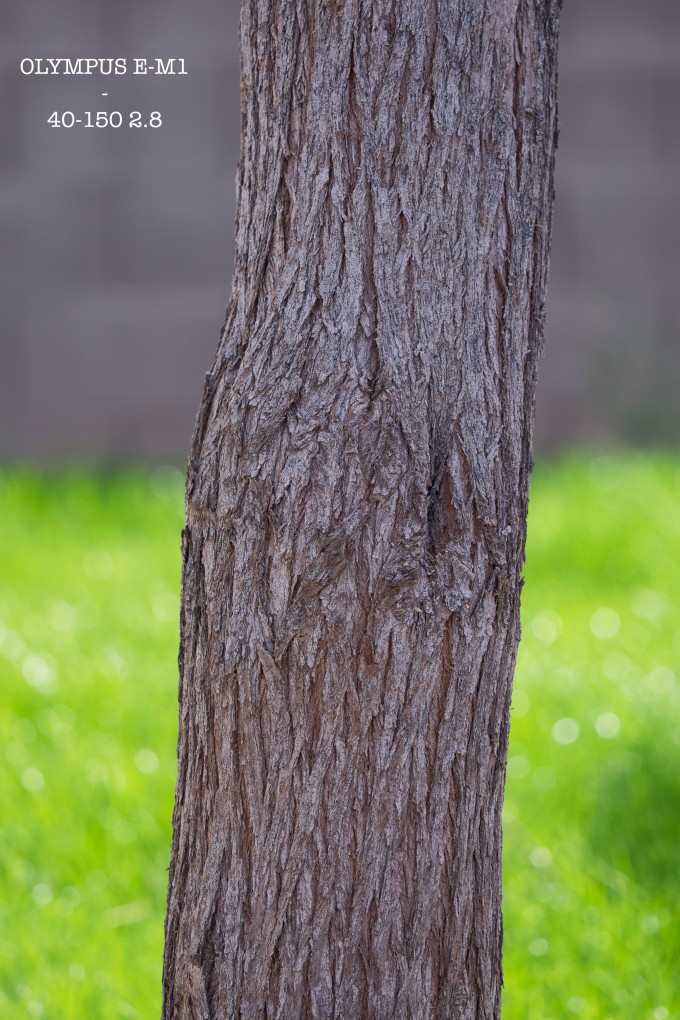
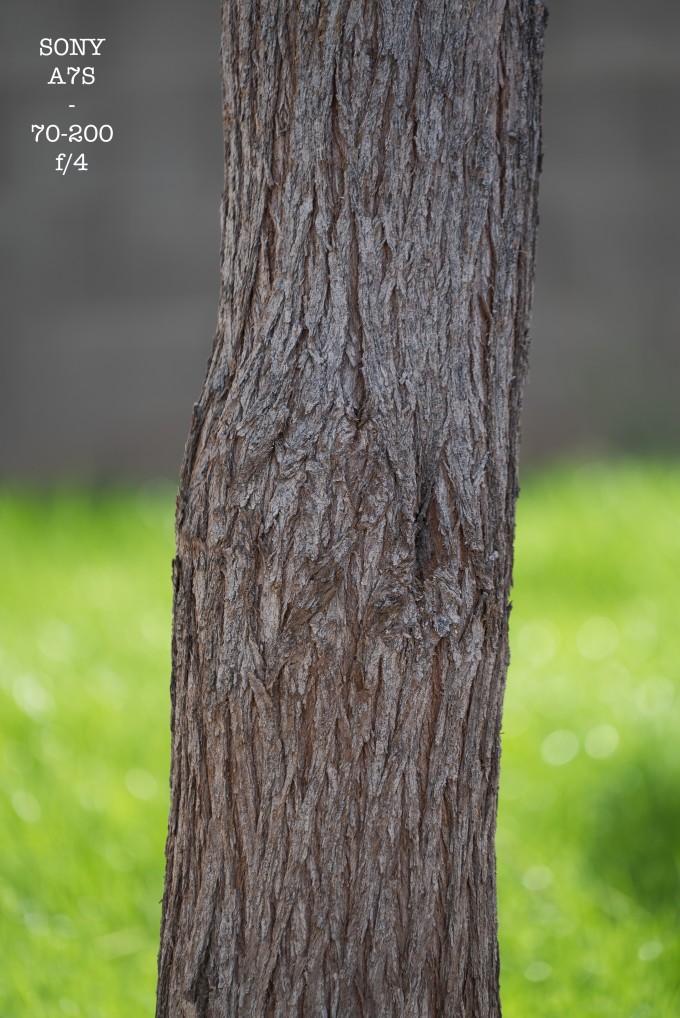
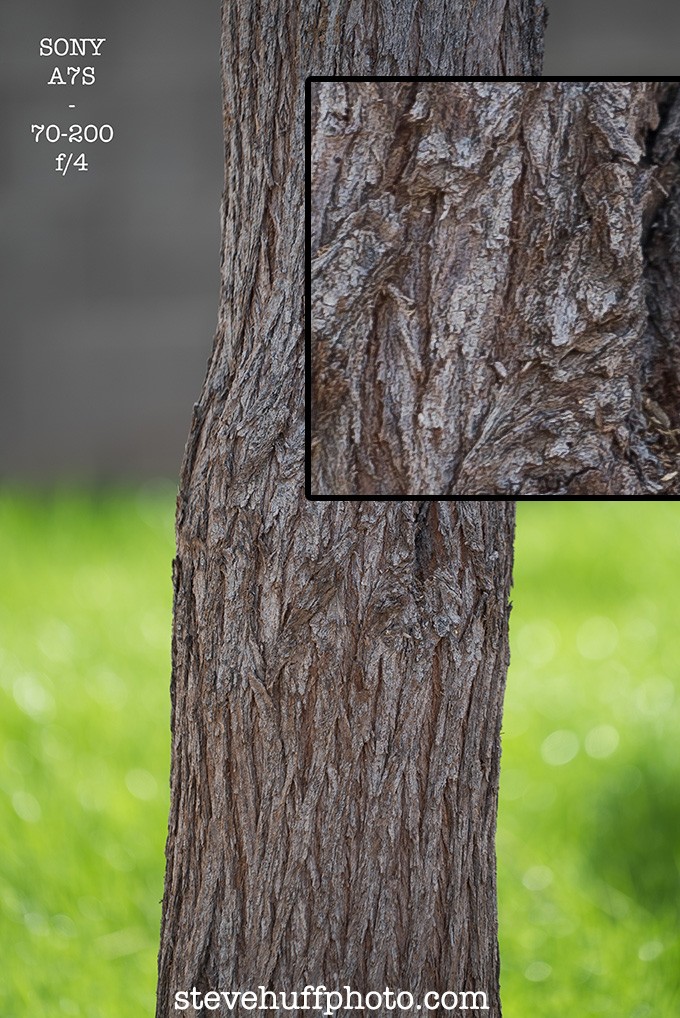
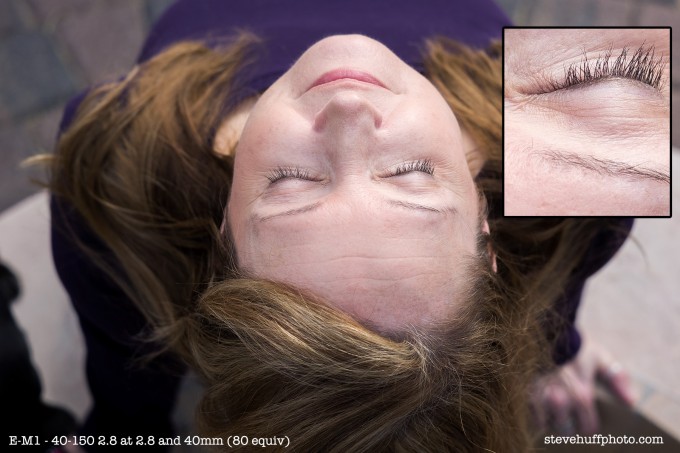
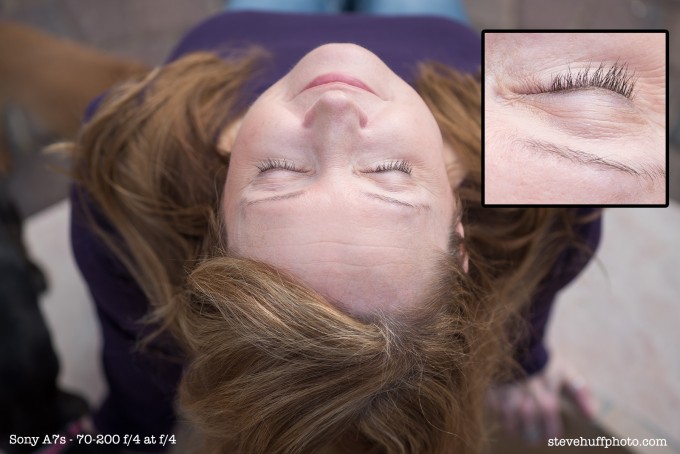
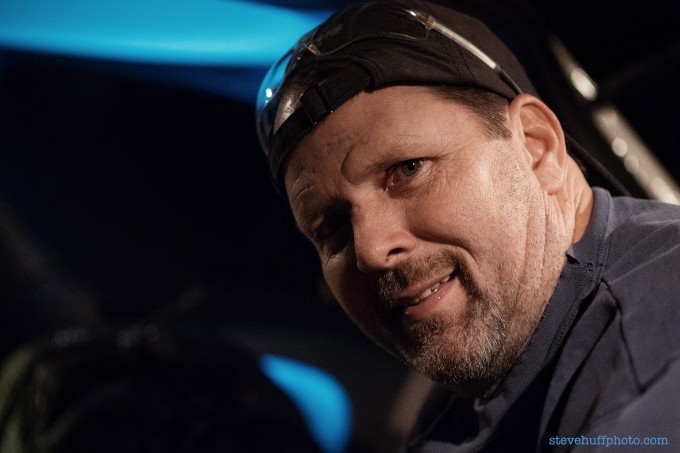
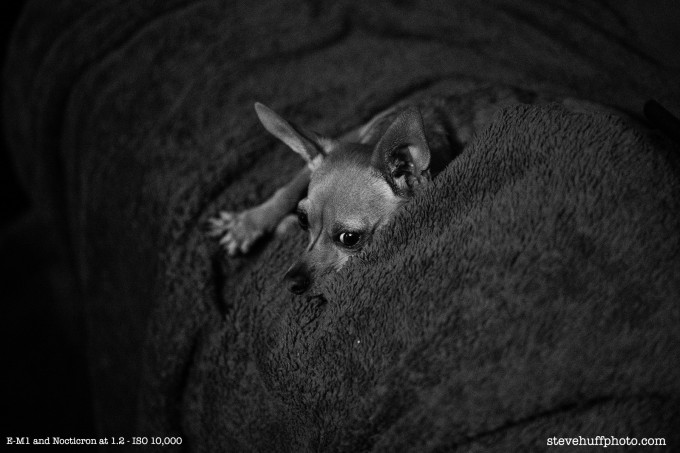
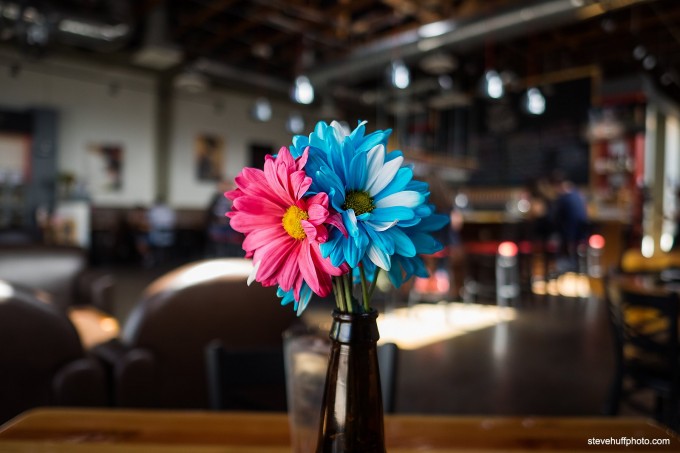



To bad you couldn’t compare this Sony against the same focal length OLY 35-100 2.0 then you would have comparable apertures 2.0 vs 4.0 instead of 2.8 vs 4.0…..
Very interesting discussion! I want to say something about perspective or “natural perspective”. That depends on the focal length of the lens, the viewing distance of the image and the enlargement ofbthe image. If I remember correctly from a more than 50 years old photo book a picture taken with a 35mm camera with a 35mm lens, enlarged to about 18x24cm and viewed at 25cm distance gave a natural perspective. This can explain the popularity of the 35mm lens!
If you use a more wide angle lens you can enlarge the image more but to get a normal perspective you have to view the image from a larger distance. The 50mm was said to give a normal perspective but then you couldn’t enlarge it so much. In the mft-world corresponds 17,5mm to 35mm when we are talking about perspectve.
I think to discuss this is at least as important and interesting as the infected DOF-discussion!
Per
I much prefer the Olympus EM1 and 40-150/2.8.
Regarding the look of the Oly images…..a lot of that depends on the picture control setting you use. Even when shooting JPG files, I shoot with a pretty flat profile. I like to get as much range as possible in my files, so I dial the saturation, sharpness and contrast back a bit. I then process what I want in post with Lightroom via presets I have setup for each of my cameras.
Yes, I should do the same. Using a “Vivid” at the moment.
I myself is definitely not a pro and at the most just a prosumer. I started my photography with a Nikon D5100 and then D600 a few years ago. When Sony A7 came to the market, I jumped to it without any hesitation because the Nikon system is just too heavy for me.
A7 really gives me the color, DR, etc. in a light and compact body. I like it very much. Just two months ago, I am lucky to buy Leica M240 at 45% off new. I am really happy shooting with the M which is so wonder in IQ. I just want to say I am someone who like camera with only good IQ in compact size. So I have never thought of buying camera with small sensor such as APS-C or M43 because I thought they cannot produce good images at all.
When I follow Steve’s site for more than a year, he keeps saying how wonderful is the OMD cam. I decide to buy one, the E-M10 (because this is not expensive US$450) and try. The day when I shot with E-M10, I left my M240 on my desk for a week and even lent it to me friend later. I just found the E-M10 is so amazing and so capable of doing a lot of things which both A7 and my Leica M which cannot do such as very fast AF, 3 axles stabilization, Live time, time lapse, etc. To my surprise the IQ is not bad at all, actually if you shoot with good lens, it can give you images which are very close to FF cam. One week later, I sold the E-M10 and upgrade it to E-M5 II which is far more capable with 5 axles and 5 stops stabilization, weather seal body, electronic shutters, live composition, etc.
I found the E-M5II has a better ISO than E-m10 and is same as that of A7. The pop effect is also better than that of the A7. I discovered this when I shot my toys with A7(with Zeiss 55mm F1.8) and E-M5II(kit zoom lens 14-150mm).
Added to that, the choice of lens is so plentiful and you can shoot whatever you like, macro or long range. There are good lens as well for e.g., the lens 40-150mm F2.8 gives you an effective range 80mm – 300mm at F2.8 and the price is only us$1200! The weight is around 800g. The nikon 70-200mm F2.8 cost you at least 40% more and 60% more in weight but 100mm less in shooting range!
Steve is right, the OMD gives you a lot of fun and has many innovative functions and features. It is doing the impossible. Of course, top model of Nikon and Canon are also capable of doing it as well but at least double the price and weight for you to do it. After all, they can only offer slightly better IQ.
For IQ, I use my Leica M. For fun or travel to desert like countries, rainy countries, cold weather, long walk, shooting insects or bird or capture a wonderful moment. I will bring my E-M5II.
Regarding the tree by Steve, I prefer the OMD file to Sony file in color, sharpness and bokeh (more rounded shape).
Steve, I like the natural look of the a7s and I really don’t like the more artificial look of the Olympus. My question is how’s the a7 II in this regard.
Also disagree with your comment about the iPad display as it is the most accurate display you can find under 3000$ and it has more resolution than your 27 inches iMac
Your iPad has more res than my 5K iMac? IN any case, the iPad has good res, but is not a good judge of a photo as they are all made to look “pleasing’ from the contrast to color, etc. I find the Olympus to have nothing artificial about the images at all, so can not answer your questions. I would suggest reading reviews of the cameras you have an interest in and pick which one does it for you. I prefer the A7Ii over any Sony A7 camera for IQ, build and usability.
Hi Steve
how does this oly zoom compare to the panny 35-100?
what would I gain (beside the extra reach) with each. I tend to look to Panasonic lenses at the longer lengths to keep my options open re future bodies
You will gain massive build quality, super weather sealing, better IQ from color, contrast and sharpness. This is a true pro lens that in my eyes beats the Nikon 70-200, Canon 70-200, etc. Its quite amazing and gives you a 80-300mm focal length. The IQ beats the Panasonic as does the build, etc. It’s one of those lenses that you would own for your lifetime with the camera.
Thanks Steve,
so the panny has cost size and i.s. in its favour, the oly has better quality in all areas.
any plans to do a comparison?
Steve, I love your crazy comparisons. In my opinion they are closer to real photography life than any other reviews. One of your great ideas – please more of this. Every time there are some new aspects, informative and remarkable results worth to discuss. Thank you and kind regards from Germany.
Steve, I love these comparisons! From what I’m seeing you can’t go wrong with either lens. The biggest differences are the signature renderings of both sensors/cameras.
But what grinds my gears is your repetition of “the light gathering of a f/2.8”. Light gathering is measured in T-stop and not F-stop. At least, the light transmission, and the gathering is then up to the sensor. I’m saying this because many lenses, and especially M43 lenses, have a much lower transmission that the F-stop would suggest.
Either way, F-stop is a relative measure for the opening of the iris, but without the other parameters gives you very little indication of the total flux of photons entering through the lens to the sensor.
I do have a PhD in this field which is why the incorrect use of terminology bothers me a bit in otherwise fantastic reviews.
To clarify my point: if you take the same picture with the same lens and the same settings, using a PEN E-P1 and an E-M1, the E-M1 will produce a cleaner (noise-free) image. This is because the lens-sensor combination effectively gathers more light. All parameters of the lens including F-stop would be considered fully equivalent (it’s the same lens), yet there is different light gathering. That’s why comparing light gathering across systems based on F-stop is a bit of nonsense.
You can calculate quite an exact equivalence for field of view (focal length) and for depth of field (F-stop) quite easily. But for light gathering you would have to do some crazy calculations for very specific parameters (transmission, sensor efficiency, etc…)
This is why people keep arguing about it. This is why no one agrees on the topic. Mostly because the basis of the discussion is wrong to begin with.
If you closed down the Sony say 1 stop (not trying to be scientific, just wondering), wouldn’t you get pretty much Olympus’s DOF and sharpness, plus the benefits of FF? I ask this because my impression is that the tree as it is flat in terms of focal distance looks similar in sharpness in both cameras, whereas the woman seems affected by DOF, and different points of focus (Sony’s is shallower thus its photo looks less sharp overall because the area in focus is much smaller).
I have the 70-200 f/4 OSS its a nice versitile lens on the Sony A7S (mine) or A7II. Sharpest at the wide end of the scale (70-135mm) in the center and also in the corners when stopped down to f/8. Good sharpness at the corners at 135 wide open at f/4. Falls off in sharpness then all the way to the 200mm end of the scale. Can’t really be used on the far end of the zoom range on the A7R unless you’re sporting a heavy duty tripod.
I’m curious if you were shooting at 80 or at 200 on these sample shots? Obviously the sony wouldn’t do well on the far end of the zoom range.
For ultimate sharpness I prefer the tamron 90mm macro A mount with A-E adapter. Sony version unlike Nikon/Canon lacks OSS though but I find the 70-200 more practical traveling.
T.
The olympus is a higher resolution sensor – essential for detail and sharpness. All lenses are so good today that higher no of pixels = better detail and sharpness (more natural too) It is the main reason for me to use a 36 mpix camera.
The Sony 70-200 is very good, but not quite as good as the same spec Nikon. Leads me to think the Oly lens is better too.
Remember the Sony A7S is a niche, low light and video, camera rather than a general purpose camera (is A7II). The A7r is a niche camera for high resolution.
It’s not as much what camera you use It’s what kind of lenses that you attach on the camera….I only use so far the SHG Oly 4/3 rd lenses on my E-M1 and the output is far less plastic looking then the micro 4/3 rd lenses…..the contrast and brokeh is outstanding with these kind of lenses but so is the Weight…Life does have it’s trade offs….
I agree with Petra that the Oly EM1 images sometimes seem a bit harsh (I own an EM1 myself).
This is good for pixel peeping but sometimes the images miss a bit of depth and 3-D.
I also agree Oly color is very good (expect skin in higher ISO) and Sony color sometimes can be a bit dull. (The A7II standard profiles seem to show some more color pop than the A7s, and there also quite some differences between different raw converters).
Having used both system for some time now I agree the Sony images to have a little more organic look overall. However, there is one lens which makes the EM1 images look like from a full frame camera: The Nocticron. Before I tried the Nocticron I didnt think its possible to create such a 3d-looking image and so nice transitions before trying that lens.
By the way – even if some will have a different opinion: IMO Leica M with M lenses gives an even smoother image than the Sony.
On the other side the Oly Tele zoom seems really usefull range and sometimes more DOF can be a plus.
I like crazy comparison.
But I like neither of the results.
Oly: too cold blooded excellent, just not “touching the emotional part”
Sony: it’s a videomakers cam with the purposeful implemented flaws for cinematix.
Prefering M for photography.
Video? hmmm, I’m not into that well enough.
next crazy comparisons:
a) Wildlife-Action: Pentax Q-S01 bird watch against Canon 50MP bird watch. Idea: “is the small thing so dull as we expect?”
b) Western-Culture: Client Steve Huff Eastwood checking for the fastest “shooter equipment”. Task: get out of pocket, aim, shoot sharp w/o getting hit yourself (single/3-shot moving target). Idea: “Really what’s the fastest Cold2SharpPic shooter for Kid-/Street-action”.
c) Biker’s culture: Hawaii shirt tourist on fast scooter shooting as he passes (people on street, people on other scooters/cars) in “wintertime” (gloves!). Get Insurance first 😉 then try Oly-M5II, RX100III, D7200, Contax T/Ricoh GR
d) Lens or Body?: take Pentax Q, mount best Zeiss/Leica M lens. Compare with D810 + Nikkor DX 18-55: Idea: have fun
I respectfully disagree Steve, as far as I can tell the Sony tree has much more pop that the olympus . Sometimes these things are subjective but in this example it’s very clear that the Sony has more 3d look ( viewing on an iPad , not calibrated screen )
I own neither but if I was to go from these examples alone in my decision making I would chose the Sony
Thats your problem. Looking at it on an iPad that artificially enhances photos 🙂 The Olympus has much more detail and pop on my large 27″ screen. Its also sharper in the corners where the Sony gets a bit soft and the Sony has a color cast as well. I have a brick shot that shows the soft corners issue on the Sony clearly but did not post it. In any case, I love both systems (as you probably know) but always tell it like it is. Without question the better lens is the Olympus from build, to size to usability to QUALITY. 100% without question. But what one prefers is up to them. Wait for my Sony, Olympus and Fuji test coming Monday. Will be much more involved as well. Should be interesting, and fun but will only use high quality fast primes. You will see the huge DOF differences between all three but also will see other things that are quite interesting. All are great systems and have their own strengths and weaknesses.
Agree Steve. Sony is soft in the corners wide open from 70 to about 135 where it gets maximum corner sharpness wide open. Both center and corner get to be quite good at f/8 throughout that range. Then both corner and center sharpness falls towards 200.
I prefer the Sony. What you call ‘pop’ is what keeps bugging me about the OMDs; they always look harsh to me and not very organic. And don’t just look at that tree, but also at the background… such a difference in noise…the Sony looks gorgeous. And no, I don’t own a Sony, I own a couple Olympus among which the OMD EM10. I keep thinking about upgrading to the EM1, but this is what’s holding me back from doing so.
I agree a bit too sharp
LOL
Really don’t often hear people say that Olympus 4/3 sensor with Olympus optics produce too sharp photos compared to Sony praised 35mm sensor and optics 😀
It can be just as sharp if not sharper. But sharpness is not what makes a great photo, not at all.
Yes! This is personal preference of course but I’m firmly in the “organic” look camp. We don’t see with our eyes at the acuity level that the OMDs render and it is a bit jarring to me. The files just look a tad crunchy, for lack of a better term.
Those that prefer the look probably think the Sony files look to soft or creamy so there you go. To each his own.
I completely agree with you, the Sony files look much nicer in my opinion, especially the tree photo. The background boheh is much more pleasing and if you want more detail from the tree it would be easy to add some sharpening.
Larger sensored cameras tend to produce images with smoother transitions between in focus and out of focus areas with richer tonal gradations (more organic). I think that this partially explains why the smaller sensored Olympus has more ‘pop’. I enjoy using both precisely because of those differences.
I jump on the wagon. At first, the Olympus photos seem to have more punch, But after looking at them for a while, Canon pics are much more natural and real, not oversharpened and their colors have a more natural gradation and contrast. Even the last Oly flowers’ pic has something not real.
I completely agree with Petra de Bruin. Even though Olympus makes excellent cameras and lenses I very often think the photos are too harsh, don’t feel organic, lack tonality. For me this is true for all m4/3 cameras and this keeps me away from the format. Although it’s not to be expected, I would very much like to see Olympus move to 24×36 mm. They have all the tech and could be highly competitive there, especially when they would apply a flange distance similar to the A7 series so any old glass can be mounted.
Yes, wishful thinking.
So I keep waiting for the rangefinder style A9S… also wishful thinking but Sony has already surprised us a few times so that dream might be a bit more realistic I hope.. end of the year Sony?
A very accurate observation. I never bonded with mft files because of their digital look. The sensor with the most natural tonal gradations to my eyes is the one in the Nikon D4/Df which produces very smooth and “elegant” looking files.
I think I preferred the Olympus in this test. Thanks, Steve.
BTW, an easy way to explain what happens when you put a full-frame lens on a Micro 4/3 camera is to say that nothing changes except AOV (angle of view). That’s it. One can work backwards from there.
Another two facts which some people get wrong (and I am not making moral judgements here!): the effect of focal length on ‘compression’ (apparent distance between subject and background); and the definition of perspective.
Focal length does not change the apparent distance between subject and background (so a Hasselblad with an 80mm lens does not have any more ‘compression’ than a Leica with a 50mm lens, give or take). Perspective does. And what is perspective? Where the camera is in relation to the objects around it. Changing focal length is not a change of perspective. Neither is rotating the camera around the lens’ optical axis. The only way to change perspective is to move the optical axis to a different point in space.
It’s probably worth an article on its own.
Sorry guys, I just fixed the Sony image. I posted the wrong one. It was from the Sony but mis focused. the one there now is focused correctly.
You want Bokeh… very close and even better then the Sony lens namely the very equivalent Oly 35-100 2.0 4/3rd lens and just as sharp…
Tested both the lenses, and have one (Sony). my conclusion is, Sony is much more comfortable, pretty fast and sharp producing nice Bokeh when needed. Olympus is bit faster to focus (often) but as I said it’s much more comfortable to walk around with a Sony.
Why is it more comfortable? The Olympus is smaller and lighter I thought?
Looked up the specs. The Olympus is slightly smaller, but weights 40g more. It is also built better and has 100mm greater telephoto reach, and is significantly faster at f2.8. Sony’s only advantage I can see is the slightly greater background blurring ability.
The 70-200 on the a6000 is extremely light and has really fast focusing (I’m not sure the em1 combo would beat it) and has the same reach, but not quite as wide, obviously.
On the A6000 the lens’s background blurring advantage would also be lost. Overall, and I am speaking as someone who doesn’t currently own either camera series or lens (only use an rx100m3 right now), it seems like the Olympus is the overall more capable combination. But obviously both are excellent.
What really amazes me is how well the m43 images hold up against the ff images. Obviously as you go higher with ISO the Sony’s will destroy the m43 sensor, but at lower ISO I’m not seeing much disadvantage for the little m43. Really incredible.
According to a test by a magazine in HK called eZone, E-M5 mark II beats or at least at par against sony A7 (of course not A7s) in high ISO.
I believe that, seems correct.
Do you have link to that review/test? I tried searching it but I can’t find it.
And neither is comfortable if you have the tripod collar attached. (In fact, both are quite uncomfortable unless you detach the collar.)
Steve, I’m sure you know that 40mm @2.8 in 4/3 = 80mm @5.6 in FF, not f4 like in your test here, why didn’t you compare apples to apples?
No, 40mm 2.8 in micro 4/3 is still 40mm 2.8. You get the LIGHT gathering of a true f/2.8 lens (FACT) and the DOF of a 40mm 2.8 lens (FACT). Light gathering is still a true f/2.8. The reason the DOF is different is because the lens is wider – 40mm vs 80mm – so slap a 40 2.8 on the A7s and you will get the same DOF as the 40 2.8 on Olympus with the FOV being 80mm on the Olympus.
Thanks, Steve, for repeating this formula once again. I’m going to copy it out this time and really take it on board!
I agree with what you’re saying. I’d tend to use the term exposure value rather than light gathering. Assuming all other exposure parameters are equal, an aperture of f/2.8 gives the same exposure regardless of sensor size. Some folks refer to total light gathering as the total amount of light hitting the sensor. I’ve simply come to the realization there’s not really such a thing as complete equivalence across sensor sizes, and I’m quite sanguine with that realization.
So, I agree with the light gathering. However, when I use an online DOF calculator, keep the same settings for the lens and just change the size of the sensor (switch from M8 to M9 for example), I get a different DOF. Is the online calculator wrong? (for reference http://www.dofmaster.com/dofjs.html)
Because the sensor is what is creating the “crop”.
This is easy:
A micro 4/3 f/2.8 lens is indeed a TRUE f/2.8 lens
You will get f/2.8 light gathering, which is what aperture is all about – letting in more light. A 40-150 will give you f/2.8 light gathering through the entire range.
Your Field of View will be doubled, so 40mm is 80mm due to the crop/smaller sensor.
BUT your DOF will be 40mm at f/2.8 not 80mm at f/2.8.
Many so tech backwards and confuses so many. Best way to look at it is to remember when you use an Olympus 17 1.8 you are using a 17 1.8 NOT a 35mm f/4 or whatever. You will get the light gathering of an f/1.8 lens, the BOKEH/DOF of a 17 1.8 lens but the magnification will be doubled to 35mm for field of view. You are NOT shooting with a 35mm lens, you are shooting a 17mm lens and are getting all of the characteristics of a 17mm lens besides the magnification effect from the smaller sensor.
See this very old article I wrote about this:
http://www.stevehuffphoto.com/2010/02/07/the-bokeh-files-featuring-the-leica-m9-olympus-e-p2/
I think I got your argument, the aperture and the focal length are lens properties, and the depth of field depends on aperture (lens), focal length (lens) and distance to subject (framing) none of it has to do with the sensor.
And I agree, I see it as the crop tool in lightroom, same light coming in, just smaller surface to gather it, hence narrower effect. I am just confused with the online calculator. It returns different DOF when you change the sensor size, probably something wrong in their formula.
Also, after reading your explanation, I re-watched this video https://www.youtube.com/watch?v=f5zN6NVx-hY and understood it differently.
Thanks!
No, the calculator is not wrong.
What many doesn’t know (or it isn’t told often enough) is that the depth of field and noise is calculated from specific physical print size, viewed from the specific distance by a person that as specific eye sight.
Example if we set that print size to like 40×32″ and then we rule that viewing distance is from 5 feet and the viewer has avarage (20/20) sight. Then we compare the photos taken from 4/3 sensor and from 35mm sensor using same lens (same 50mm f/1.8 @ f/2.8) with adapter.
Now the photo from 4/3 sensor has deeper depth of field because we were standing 2 times further. The magnification difference is 2x.
The noise is as well 2 times worse because we have enlarged the print by factor of 2.
But we get exactly the same exposure values (shutter speed, ISO and aperture).
When we enlarge the image, we enlarge all the flaws as well.
So if we keep camera distance same and we take photo from same center point, the 4/3 image is a 1/4 crop of the 35mm image, but because we enlarge it 2 times larger (to same 40×32″ print size) we enlarge the as well the airy disk, hence we get shallower depth of field from same distance with same aperture value and same focal length. We as well get 2 times more visible noise compared to 35mm with same ISO value.
But to get the same ISO look, we should keep the 4/3 print in 1:1 ratio to 35mm, meaning the 4/3 print size would be 20×16″ instead 40×32″ and we would have same ISO quality at same ISO value, but we would have same depth of field as well because we don’t enlarge anything. And we would have same exposure. But we would have just 1/4 of the area captured compared to 35mm image.
It is all about magnification. Inverse square law how much we enlarge the print. It has nothing to do with light gathering for sensor size etc, as those are identical. It is about enlarging the print.
The inverse square law is automatically taken care by the aperture (that’s why it is ratio instead fixed size).
What many doesn’t know, is that shorter focal length gathers more light than longer focal length. Again in same inverse square law amount. So if you have aperture size of 25mm (no ratio but physical opening) and you have 50mm focal length and 25mm focal length, then 25mm will gather two times more light than 50mm does because its magnification is two times smaller from same distance. Why aperture is a ratio instead fixed size. 25mm focal length with 25mm aperture would be f/1. 50mm focal length with 25mm aperture would be f/2. But if we use just the ratio like f/2, then 25mm has aperture of 12.5mm and 50mm has f/2 = 25mm.
It is just all about magnification = distance, focal length, enlargement etc.
Thanks for your answer,
First of all, I agree about your last comment, shorter focal length gather more light, hence the need for a ratio to compare apples with apples and not just the size of the pupil.
But I think we got confused on the definition of DOF, I really don’t see what it has to do with print size. Once the light has gone through the lens and has been captured by the film/sensor, the DOF won’t change anymore, no matter how you print your image or view it on a screen.
Come to think of it, maybe you mean framing, if you want to frame the same, you need to move either forward or back depending on the size of the sensor/film hence affecting the DOF.
And I will leave the noise aside, as it was not the original point.
If you are considering using the Sony and/or the Olympus in low light, read on.
I have regularly used both lenses (twice or more monthly) to shoot low light theatrical events (as an official photographer) where flash is not permitted. I have come to love the Oly 40-150 and equally detest the Sony 70-200 in low light. My Olympus EM1/40-150 hit rate is very high, and using the 1.4x converter is a breeze, when needed. The Sony’s hit rate is abysmal and it often won’t find focus at all, or the focus confirmation light / box is lit but the focus has clearly not been achieved. I’ve tried every focus mode offered by Sony and none works reliably or quickly in low light with this lens. And shooting moving subjects in low-light in a theater isn’t ideal (at least for me) for manual focusing, even with focus peaking, due to lousy vision.
I’ve used both the A7S and A7II with the 70-200, with similarly poor results/ I’ve had great results, though, with other lenses–and I far prefer the ergonomics of the Sony A7 series to the EM1, where I can change ISO, shutter speed and aperture instantly (using the back dial for ISO is particularly wonderful and the high ISO of the A7S enables me to dial in manual exposure very rapidly as stage lighting conditions change or when I need to up the shutter speed due to scenes with more motion). But for reliable low-light shooting from the back of the theater, the Oly 40-150 wins, hands-down.
In normal light, the Sony 70-200 is fine, so I don’t think the lens is defective. (And I have no similar problem with any other Sony lens.) If I had any other realistic long lens options, I’d sell the Sony 70-200 f4 in a heartbeat. I’ve tried using the wonderful and lightweight Canon 70-200 f4 w a Metabones adapter, but it is too slow and cumbersome. Has anyone else figured out how to shoot the A7S/70-200 reliably in low light?
I just purchased the sony 70-200. I’m very disappointed with it. Its a very dark f4. The rendering isn’t what I was hoping for. The af is very slow if the subject is between min distance and about 5 meters. AF missed a bunch. Eye AF wouldn’t kick in. Like all sony af e mount lens it doesn’t work in anything less than the best light.
Cameras tested on a3000, a7 and a7ii.
In daylight with af-C turned on tracking an air show’s simulated battle. The hi speed mode managed to track subjects. Inside a house in the mid of the day windows opened a sleepy baby was to much for the af. This type of af inconsistently is common to all my f/e glass expect the kit lenses which seam to work
yes i agree with all your findings…M43 sensor photos appear sharper..but for me they all quite flat image.. even @ f4 it is still has shallower DOP compare to f2.8 of m43…image quality is not all about sharpness..i have various cameras apsc, m43 and ff..nothng beats full frame in image quality..
See my test from today. Thanks
Steve, do something on exposure. You make an excellent point there.
Actually, regarding DOF, f/2.8 on MFT translates to f/5.6 on 35mm. So it’s no surprise that the bokeh of the Sony is creamier at f/4.
Yes, you are right. But the DOF difference between f4 and 5.6 is fairly small, as these images show. The Sony has a very slight upper hand in terms of background blur. But in all other respects the Olympus lens does appear to be the better lens. Sharper, greater reach, smaller, lighter, more robust, and a good deal faster in light gathering terms making it better for shooting moving subjects.
Now, I wonder what difference the Sony might’ve showed on the A7 II, which has twice the sensor resolution of the A7S, and 50% more than the Em1. Would the Sony images then be the sharper images?
Great point about the depth of field difference being very small between f4 and f5.6. On so many forums I see people only comparing the subjective difference in depth of field so I actually calculated it for these 2 lenses at 10 feet at their widest ends and widest apertures, the difference is only 6 inches (1.12 ft vs 1.61 ft). Is that going to make or break a photo? Thats another subjective difference that only the photographer or viewer can determine. Sure in a portrait, the subject’s ears will be less in focus than the eyes with the full frame. I don’t know about anyone else but its more often distracting background elements than ear vs eye focus that blow the shot for me and you could just have the subject stand 6 inches closer than said background element with Oly.
We can go for the high end prime comparo and pit the Zeiss Loxia 50mm F2.0 e-Mount ($949) vs the Voigtlander 25mm F0.95 MFT ($999) and the difference at 10 feet wide open (or rather F1 for the MFT lens because I can’t find a calculator that goes wider) becomes 1/100th of an inch…..or rather……nothing.
With 35mm film, APS-C digital, and now micro 4/3rd, I have experienced situations with each format where the depth of field was more narrow than my focusing abilities allowed for reliably.
I tried to do a thought exercise out of what difference the sensor resolution of the A7II would have on sharpness compared to the E-M1, I got as far as looking up their pixel pitch (5.93 vs 3.72 respectively) and then I got lost in a lot of science. I think it might come down to which sensor resolution a particular FF E-mount lens matches best as they are trying to make the same lenses match sensors with 3 different densities compared to Olympus sensors that are all the same density. Some of the sciency mumbo-jumbo seemed to indicate that would make a difference. Perfectly matched lens to the A7II maybe sharper?
I think my point is one that Steve routinely makes: there are sooooooo many good cameras on the market now! We got a lot of great choices and it now comes down to a lot of user preference factors instead of technological advancements.
Got rid of my 70-200 f/4 in favor of a Minolta 200mm f/2.8 G with adapter. Works amazing on the Sony and is light and fantastic. Bokeh is amazing. Obviously you lose the versatility of the zoom but I’m a prime guy.
Fun comparo! I often suspect that one reason Olympus photos are so sharp is that the in-body IS works so well… even at speeds where you might not think stabilization is relevant. Did you test the Sony lens with its IS turned on? Does it seem as effective as the Olympus IS?
When you do the Fujinon comparison, I suggest you throw a ringer into the mix in for from of the Fujinon XC50-230 4.5-6.7 OIS which does a superb job despite it’s $399 street price. I bought mine on eBay for less than $200 and it’s resolution and fast-focusing are on a part with my Fujinon 18-55 and 18-135 zooms. I bought it in spite of its low price, because it is so much lighter and faster handling than Fuji’s other telephotos I figure that for $200, what do have to lose? Also, because I typically use telephotos in daylight and the OIS, the small aperture isn’t really a penalty for me. I find I can handhold it with no problems at 1/30 of a second when it’s fully extended to its 350mm equivilent. No kidding, include it in your upcoming comparison and be prepared for big surprise!
Steve, when you do the XT-1, EM-1 and sony comp. please use the A7II as that would probably be the shortlist for most. I think the A7S is more of a specialty camera. Of course the one camera you would be missing in such a great comparison is the Samsung NX-1, IMHO.
Meant “…but on what, specifically, did you focus…”
Interesting.. to me in the last shot, the focal point isn’t her eyelashes, it appears to be right where her hairline starts for the a7s. I actually have the a7s and a7ii and the 70-200 is sharper for me, than what you showed in the blown up areas. If you get a chance, open up the a7s of her and look right where her hairline starts in the center and see if it is sharper.
I agree, the eyelashes are not in focus on the A7S shot.
They are now..
The Sony file now looks much better. More natural and extremely sharp while the Olympus looks like it has been over sharpened in an attempt to make up for sensor size. It gives it an instant pop/wow appeal that the more you look at it, the more it looks artificial.
I’m curious as how you missed focus on that image. The hairline is a long way away from the eye lashes. What focus technique was used (single spot?)
I agree, the sony looks much better to me as well.
Yup, the Sony’s point of focus/incorrect focus is the hairline.
So, does this mean the Olympus focuses better? It’s kinda a hard comparison as the Olympus has a greater depth of field, which will mask focus errors.
Maybe the quick answer is to show 100% crops of the hairline?
I agree, it looks like Sony focused on the hair, not eyebrows.
Going for popcorn =)